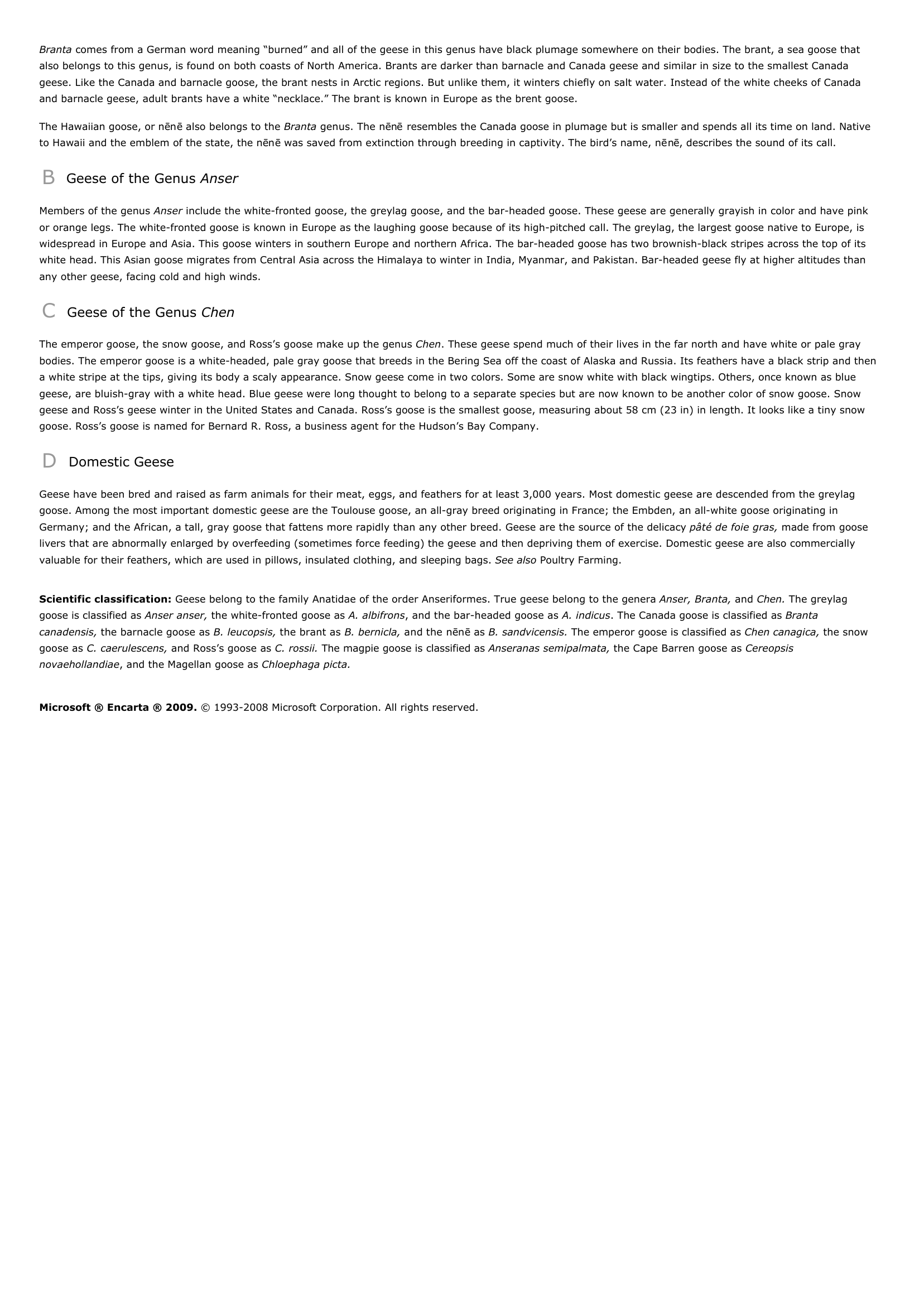Goose - biology.
Publié le 11/05/2013

Extrait du document
«
Branta comes from a German word meaning “burned” and all of the geese in this genus have black plumage somewhere on their bodies.
The brant, a sea goose that also belongs to this genus, is found on both coasts of North America.
Brants are darker than barnacle and Canada geese and similar in size to the smallest Canadageese.
Like the Canada and barnacle goose, the brant nests in Arctic regions.
But unlike them, it winters chiefly on salt water.
Instead of the white cheeks of Canadaand barnacle geese, adult brants have a white “necklace.” The brant is known in Europe as the brent goose.
The Hawaiian goose, or nēn ē also belongs to the Branta genus.
The n ēnē resembles the Canada goose in plumage but is smaller and spends all its time on land.
Native to Hawaii and the emblem of the state, the n ēn ē was saved from extinction through breeding in captivity.
The bird’s name, n ēnē, describes the sound of its call.
B Geese of the Genus Anser
Members of the genus Anser include the white-fronted goose, the greylag goose, and the bar-headed goose.
These geese are generally grayish in color and have pink or orange legs.
The white-fronted goose is known in Europe as the laughing goose because of its high-pitched call.
The greylag, the largest goose native to Europe, iswidespread in Europe and Asia.
This goose winters in southern Europe and northern Africa.
The bar-headed goose has two brownish-black stripes across the top of itswhite head.
This Asian goose migrates from Central Asia across the Himalaya to winter in India, Myanmar, and Pakistan.
Bar-headed geese fly at higher altitudes thanany other geese, facing cold and high winds.
C Geese of the Genus Chen
The emperor goose, the snow goose, and Ross’s goose make up the genus Chen .
These geese spend much of their lives in the far north and have white or pale gray bodies.
The emperor goose is a white-headed, pale gray goose that breeds in the Bering Sea off the coast of Alaska and Russia.
Its feathers have a black strip and thena white stripe at the tips, giving its body a scaly appearance.
Snow geese come in two colors.
Some are snow white with black wingtips.
Others, once known as bluegeese, are bluish-gray with a white head.
Blue geese were long thought to belong to a separate species but are now known to be another color of snow goose.
Snowgeese and Ross’s geese winter in the United States and Canada.
Ross’s goose is the smallest goose, measuring about 58 cm (23 in) in length.
It looks like a tiny snowgoose.
Ross’s goose is named for Bernard R.
Ross, a business agent for the Hudson’s Bay Company.
D Domestic Geese
Geese have been bred and raised as farm animals for their meat, eggs, and feathers for at least 3,000 years.
Most domestic geese are descended from the greylaggoose.
Among the most important domestic geese are the Toulouse goose, an all-gray breed originating in France; the Embden, an all-white goose originating inGermany; and the African, a tall, gray goose that fattens more rapidly than any other breed.
Geese are the source of the delicacy pâté de foie gras, made from goose livers that are abnormally enlarged by overfeeding (sometimes force feeding) the geese and then depriving them of exercise.
Domestic geese are also commerciallyvaluable for their feathers, which are used in pillows, insulated clothing, and sleeping bags.
See also Poultry Farming.
Scientific classification: Geese belong to the family Anatidae of the order Anseriformes.
True geese belong to the genera Anser, Branta, and Chen. The greylag goose is classified as Anser anser, the white-fronted goose as A.
albifrons , and the bar-headed goose as A.
indicus .
The Canada goose is classified as Branta canadensis, the barnacle goose as B.
leucopsis, the brant as B.
bernicla, and the n ēn ē as B.
sandvicensis. The emperor goose is classified as Chen canagica, the snow goose as C.
caerulescens, and Ross’s goose as C.
rossii. The magpie goose is classified as Anseranas semipalmata, the Cape Barren goose as Cereopsis novaehollandiae , and the Magellan goose as Chloephaga picta.
Microsoft ® Encarta ® 2009. © 1993-2008 Microsoft Corporation.
All rights reserved..
»
↓↓↓ APERÇU DU DOCUMENT ↓↓↓
Liens utiles
- Alligator - biology.
- Amphibian (animal) - biology.
- Basilisk - biology.
- Boa - biology.
- Caecilian - biology.


